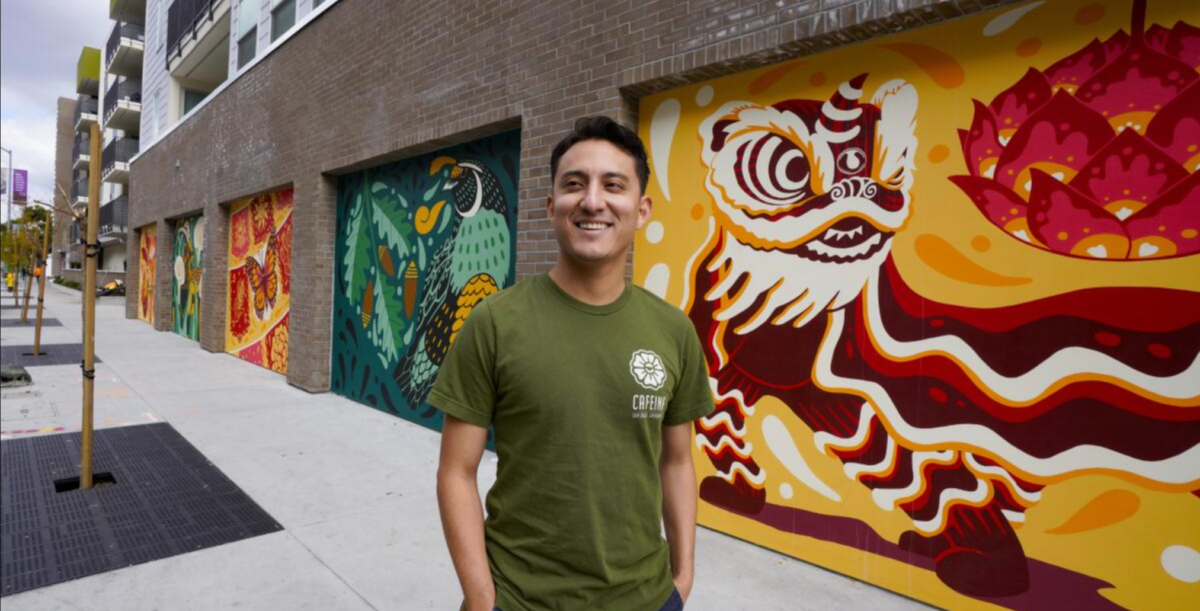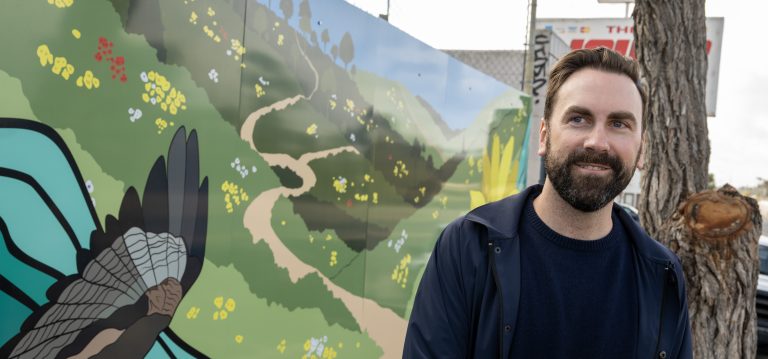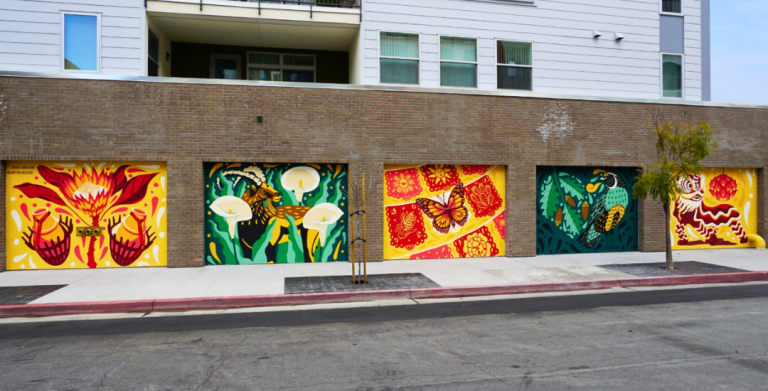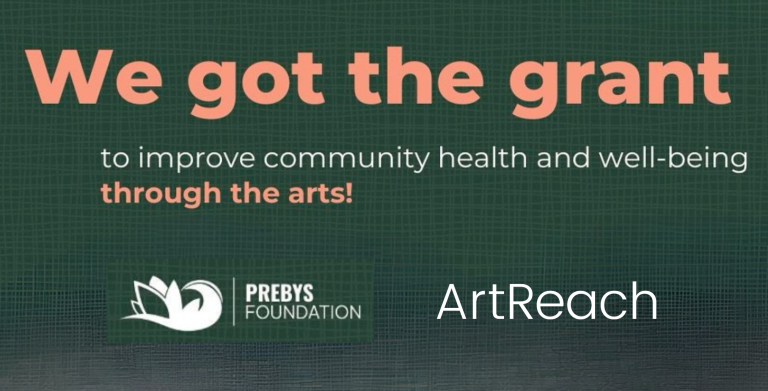Josué Baltézar is a Mexican-American artist and designer who served as the lead muralist on a project for the Plaza del Sol apartment complex in City Heights
LISA DEADERICK | THE SAN DIEGO UNION-TRIBUNE
MARCH 2, 2024
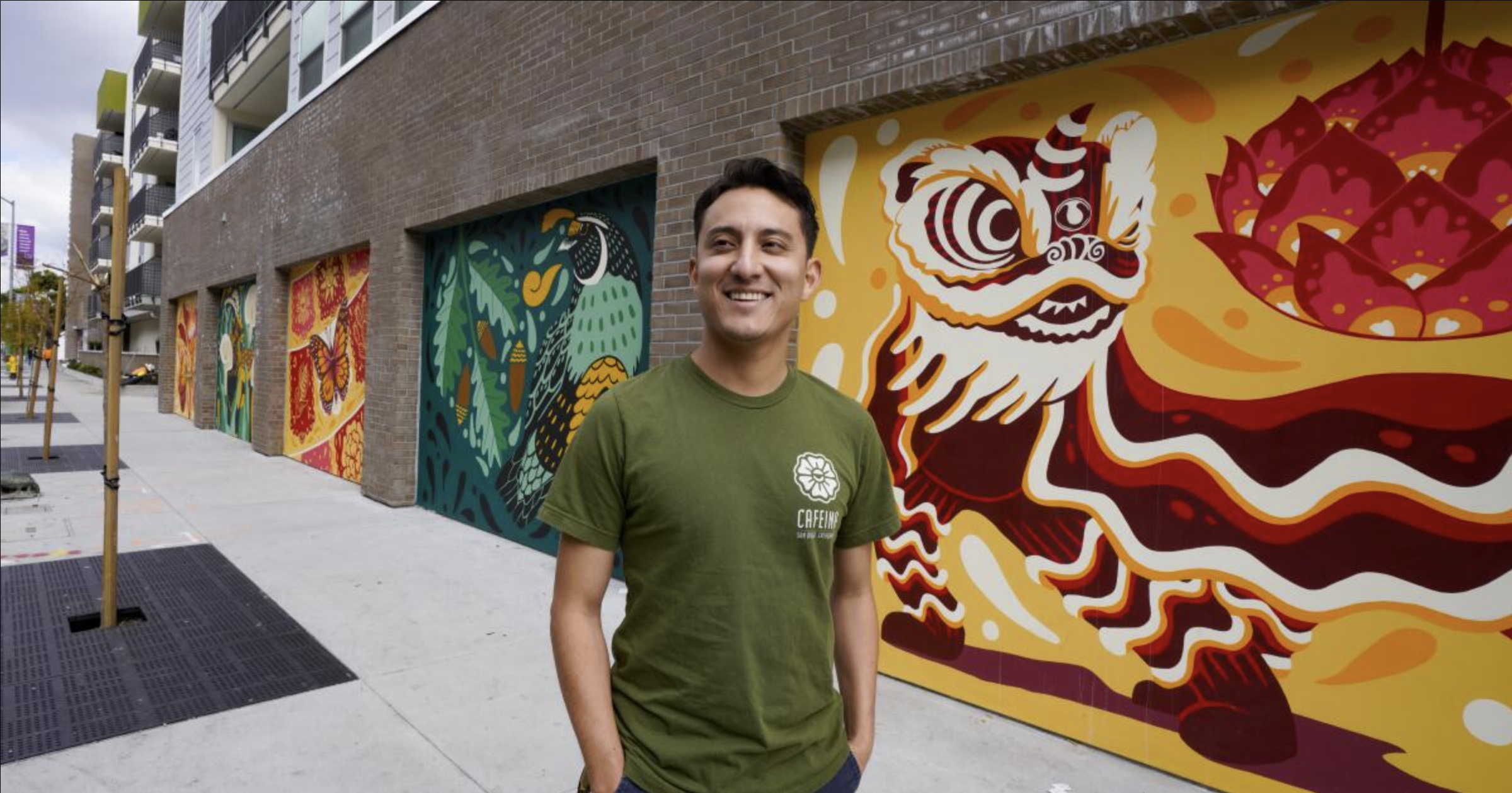
Josue Baltezar on Feb. 29 at the six-panel mural on the Plaza del Sol apartment complex in City Heights. (Nelvin C. Cepeda/The San Diego Union-Tribune)
Next to a chicken-and-waffles spot and a convenience story on Fairmount Avenue, between University and Polk avenues in City Heights, the wall of an apartment complex has a story to tell in six parts — and the lead artist on the project has his own story, too.
“Being able to create public art is a huge honor for me, especially when it’s a community-driven design that lives in a super diverse neighborhood,” says Josué Baltézar, muralist and visual artist. “The fact that the mural lives on the side of a new affordable housing complex made it even more special.”
After previously working on other murals with ArtReach, a local nonprofit providing community arts programming for children, families, and neighborhoods, the organization approached Baltézar about the City Heights project. (A mural dedication ceremony was originally scheduled for today, but has been postponed for a later date in April due to expected inclement weather.)
Baltézar, 32, specializes in murals, illustrations, and branding, with a commitment to working with people and organizations focused on social justice. He lives in Spring Valley with his girlfriend, Deb, and took some time to talk about his work on this project and how his own lived experience immigrating to the U.S. from Mexico informs his artistic perspective and the work he creates.
How would you describe your own relationship with City Heights and how did that inform the way you approached creating this mural?
I grew up in Chula Vista as an undocumented student for over a decade and felt both supported by my local community and marginalized by my immigration status. Because of my experience as an immigrant who feels that San Diego is my hometown (I arrived in the U.S. a few weeks before turning 6), and now as an American citizen, I feel a sense of responsibility to show up for immigrant communities. I’ve been fortunate to work on a few projects in City Heights, including teaching several youths from the area about creating public artwork, in collaboration with artists Leslie de La Torre and Andrea Castelo. I also recently designed the refreshed brand identity for Cafeina Cafe, a local coffee shop just a few blocks from the mural site. Although I didn’t grow up in City Heights, I feel a sense of belonging in the area. When I was asked to be the lead artist on this mural, I was excited and also hoped that the design would be well received by the people who would pass by this mural daily.
What I love about Spring Valley…
Where my girlfriend and I live now in Spring Valley we have some awesome neighbors that we’ve slowly been getting to know, and we’re close to friends and family in the South Bay.
What your process for conceptualizing this mural?
ArtReach collected design input from the community so that the mural would truly reflect the people who live there. We invited folks to attend a community listening session where they could tell us what living in the area means to them and how they’d like to be visually represented. For those who couldn’t make it in person, ArtReach also provided an online submission form. We got so many great answers; kids and people of all ages participated. That’s one of my favorite parts about creating a mural with ArtReach, the input from either the school, community, or business that we’re working with. Once we collected all of the responses, I looked for recurring words/phrases/themes and started thinking of ways to visually represent them. I also asked a few friends from City Heights if they could provide some guidance for some of the communities I wanted to represent.
The six panels represent some of the prominent cultural groups in the neighborhood, including Somalian, Ethiopian, Mexican, Kumeyaay, and Vietnamese. Can you talk about some of the symbols chosen to represent the cultures in their respective panels and why those images became the final version for this mural?
For the Somali community, I chose the King Protea flower and Haan containers [used by Somali nomads to hold water or milk] because the King Protea is the country’s national flower, and Haan containers are a cultural staple. Thankfully, I was able to ask a Somali friend for advice on this panel. For Ethiopia, I chose their national flower, the calla lily, as well as an endangered and endemic subspecies of mountain goat, the Walia ibex, to represent a supportive community surrounding the delicate nature of immigration. The papel picado elements [colorful sheets of paper with intricate cut-outs] on the Mexican panel represent food staples with nopales and maize, pre-Hispanic culture with the “ollin” symbol, cempasúchil (marigold) to represent our ancestors, and sun to represent positivity and life.
The Vietnamese lion dance and lotus flower lantern make up the Vietnamese panel (I also asked an artist friend for guidance on this panel). I aimed to pay homage to the fact we’re on unceded Kumeyaay land by showing oak leaves and acorns, staples for the Kumeyaay, along with the California quail, which is our state bird, to represent our local wildlife. The last panel features a leopard shark found along our beaches like La Jolla, surrounded by kelp, and two California least terns flying above that—an endangered species that nests in our Mission Bay/Pacific Beach areas. The overarching theme for all the panels is that diversity and migration can be very fragile, yet can be strengthened with community. I use vibrant subjects and wildlife to represent these themes, in the hopes that people can appreciate and want to learn more about the message and meaning behind the art.
How were you introduced to visual arts?
I’ve been drawing since I learned to read and write. My parents never discouraged me from drawing, and they encouraged and supported me when I leaned more heavily into art and design. I didn’t start painting until high school, where I took art as an elective. I don’t consider myself a strong writer and I don’t know how to play instruments (yet), so I felt that creating visual art was my way of expressing my creativity.
How would you describe your point of view, as an artist? And how do we see that point of view showing up in this mural in City Heights?
I like to use animals and wildlife to represent social justice values and, overall, try to paint either positive or optimistic scenes. I want my art to feel uplifting, especially when the subject matter is delicate or difficult. For this mural, I painted migration and diversity as strengths that make our community better, but some people believe the opposite is true. This mural is positive and also steadfast in its message.
What are some ways that growing up in San Diego has influenced who you are as an artist today?
Living in San Diego as an undocumented immigrant influenced the type of art I like to do, pulling from my Mexican heritage, the resiliency of immigrants, and the beautiful mix of coast, city, mountain, and desert that we have here.
What is the best advice you’ve ever received?
My dad always tells me, “Si vas a hacer algo, hazlo bien” which means “If you’re going to do something, do it well” and I try to carry that out, especially in my art.
What is one thing people would be surprised to find out about you?
I love animals and often include them in my artwork, but I’ve never had a pet! My girlfriend and I have talked about getting a dog; hopefully, we can do that sooner rather than later.
Please describe your ideal San Diego weekend.
My ideal weekend in San Diego would be grabbing coffee at Cafeina Cafe in City Heights early in the morning, riding my bike along the South Bay bike trail, playing soccer at the beach, working on a painting or drawing at home, seeing my friends, and spending time with my girlfriend and family.
Click to read the full article online >>

